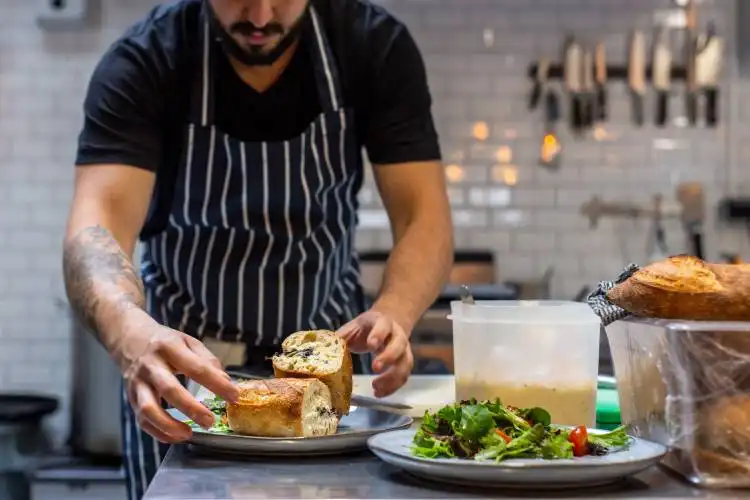Start a Food Kiosk Business
Harness the Power of 'Grab-and-Go': Venturing into the World of Food Kiosk Business
| Updated


FOOD KIOSK BUSINESS
A food kiosk business may just be the perfect dish on your entrepreneurial menu! This venture capitalizes on the "grab-and-go" culture, providing fast meals to time-starved, culinary adventurous folks. Essentially, the food kiosk business operates in busy public areas, serving quick bites ranging from hot dogs to gourmet sandwiches. So, if you can handle the heat, step right into the kiosk kitchen and cook up some business success!
Jump to Business Plan
RELATED BUSINESS IDEAS
Browse ALL Food & Beverage Entrepreneurship Business Ideas
Discover Your Perfect Domain
Unlock the door to your online success with our hand-picked selection of premium domain names. Whether you're starting a new venture or rebranding an existing one, the right domain can set the tone for your digital presence. Browse through our curated list, each with its unique potential to enhance your brand's visibility and credibility.
FOOD KIOSK MINI BUSINESS PLAN
This a quick reality check to help you identify the strengths and weaknesses of your business concept before you dive in.
Expected Percent Margin:
- Gross Margin: 60-80%
- Net Profit Margin: 15-25%
Earnings Expectations:
- Daily Earnings: $100 - $300
- Weekly Earnings: $700 - $2,100
- Monthly Earnings: $3,000 - $9,000
- Annual Earnings: $36,000 - $108,000
Actions to Hit Those Numbers:
Product Sourcing & Inventory Management:
- Initial Investment: Investment may vary ranging from $5,000 to $20,000 for equipment, ingredients, and initial inventory.
- Supplier Relationships: Build relations with 2-3 reliable suppliers for consistent supply of ingredients.
Marketing & Customer acquisition:
- Initial Promotion: Distribute sampling of your products in nearby areas to attract attention.
- Social Media and Online Presence: Regularly post on platforms like Facebook and Instagram showcasing your unique offerings.
Sales & Customer Experience:
- Effective Pricing: Start with competitive pricing to attract customers. As the business grows, you can gradually increase the price.
- Customer Feedback: Showcase positive customer feedback on your stall and online platforms to improve credibility.
Cost Control:
- Rent and Utilities: If possible, prefer a busy location with reasonable rent. It should be no more than 10% of expected monthly sales.
- Wages: Employ 1 or 2 part-time staff initially and increase according to requirement.
Business Operations:
- Opening Hours: Open late hours during weekdays to cater to the working population. Weekends can follow regular hours.
- Transaction volume: Aim for at least 50-80 transactions per day.
These are just projected numbers and can vary based on local conditions, competition, and your business strategy. Always remember to adopt a customer-first approach to be successful.
NOT WHAT YOU HAD IN MIND? Here are more ideas



Browse ALL Food & Beverage Entrepreneurship Business Ideas
Grab Your Business Website Name
Before you get caught up in the whirlwind of setting up your business, invest in a domain name. It's a small but significant step that lays the foundation for your brand and makes it easier for customers to find and trust you. Just like you wouldn't build a house without securing the land first, don't build a business without securing your domain name.
"Why? Can't that wait?" Here's why it shouldn't
Step 1: Determining if the Business is Right for You
Breakdown of Startup Expenses
When starting a food kiosk business, it is important to understand the startup expenses associated with the endeavor. These expenses can include the cost of the kiosk itself, any necessary permits or licenses, the cost of any necessary equipment, and the cost of any necessary ingredients or supplies. Additionally, it is important to consider the cost of any marketing or advertising that may be necessary to get the business off the ground. It is also important to consider the cost of any necessary insurance, as well as any potential legal fees that may be associated with starting a business.
Breakdown of Ongoing Expenses
In addition to the startup expenses, it is important to consider the ongoing expenses associated with running a food kiosk business. These expenses can include the cost of ingredients or supplies, the cost of any necessary equipment, the cost of any necessary permits or licenses, and the cost of any necessary insurance. Additionally, it is important to consider the cost of any necessary marketing or advertising, as well as any potential legal fees that may be associated with running the business.
Examples of Ways to Make Money
There are a variety of ways to make money with a food kiosk business. One of the most common ways is to sell food items such as hot dogs, burgers, sandwiches, and other items. Additionally, it is possible to make money by selling drinks, snacks, and other items. It is also possible to make money by offering catering services or by offering special events such as food tastings or cooking classes. Finally, it is possible to make money by offering delivery services or by partnering with other businesses to offer discounts or promotions.
Step 2: Naming the Business
When it comes to naming a business, it is important to choose a name that is memorable, unique, and reflects the values of the business. It is also important to make sure the name is not already in use by another business. One way to come up with a great name is to brainstorm ideas with friends and family. Think of words that reflect the type of business you are starting, such as “Fresh” or “Delicious”. It is also important to consider the domain name and social media handles that are available for the name you choose. Once you have a list of potential names, research them to make sure they are not already in use. After you have chosen a name, register it with the appropriate government agencies. This will ensure that the name is legally protected and no one else can use it.
Step 3: Obtaining the Necessary Licenses and Permits
Before starting a food kiosk business, it is important to make sure that all of the necessary licenses and permits are obtained. This will help to ensure that the business is operating legally and is in compliance with local regulations.
Researching Local Regulations
The first step in obtaining the necessary licenses and permits is to research local regulations. This includes researching the requirements for operating a food business in the area, as well as any other regulations that may apply. It is important to be aware of any zoning laws or other restrictions that may apply to the business. Additionally, it is important to research any health and safety regulations that must be followed.
Obtaining Business Licenses
Once the local regulations have been researched, the next step is to obtain the necessary business licenses. Depending on the location, this may include a food service license, a business license, and any other licenses that may be required. Additionally, it is important to make sure that any necessary insurance policies are obtained. This will help to protect the business in the event of any unforeseen circumstances.
Once all of the necessary licenses and permits have been obtained, the business can begin to operate legally. It is important to keep all of the licenses and permits up to date, as any changes in the regulations may require additional licenses or permits. Additionally, it is important to make sure that all of the necessary paperwork is filed with the local government, as this will help to ensure that the business is in compliance with all of the regulations.
Step 4: Choosing a Location
When choosing a location for a food kiosk business, there are several factors to consider. First, the location should be in an area with a lot of foot traffic. This will ensure that there are plenty of potential customers who can see the kiosk and potentially purchase food from it. Additionally, the area should be safe and secure, as it will be a place where customers will be spending their money. Finally, the location should have access to utilities such as electricity and water, as these are necessary for running a food kiosk business.
Researching the Local Regulations
Once a potential location has been identified, it is important to research the local regulations that may apply to the kiosk. This includes zoning regulations, health and safety regulations, and any other regulations that may apply to the business. Additionally, it is important to research any permits or licenses that may be required to operate a food kiosk in the area. This research should be done before signing any leases or agreements, as it will help to ensure that the business is in compliance with all local regulations.
Negotiating a Lease
Once the research has been completed and the location has been chosen, it is time to negotiate a lease. This should include the length of the lease, the amount of rent, and any other terms that may be applicable. It is important to negotiate a fair lease that will benefit both the landlord and the business. Additionally, it is important to ensure that the lease is in compliance with all local regulations.
Securing Utilities
Once the lease has been negotiated, it is important to secure the necessary utilities for the kiosk. This includes electricity, water, and any other utilities that may be necessary for the business. It is important to ensure that the utilities are in working order and that they are sufficient for the needs of the business. Additionally, it is important to ensure that the utilities are in compliance with all local regulations.
Step 5: Setting Up the Kiosk
Choosing the Right Equipment
When setting up a food kiosk business, it is important to choose the right equipment. Depending on the type of food kiosk business, the equipment needed can vary. For example, if the kiosk will serve hot food, the business will need a deep fryer, a stove, and a refrigerator. If the kiosk will serve cold food, the business will need a refrigerator, a freezer, and a microwave. Additionally, the kiosk will need a cash register, a point-of-sale system, and a variety of utensils, such as tongs, spatulas, and ladles. It is important to research the different types of equipment available to ensure that the kiosk is properly outfitted.
Setting Up the Kiosk
Once the right equipment has been chosen, it is time to set up the kiosk. This includes finding the right location, such as a shopping mall, a park, or a busy street corner. It is important to consider the foot traffic in the area, as well as the cost of rent. Additionally, the kiosk should be properly outfitted with the equipment chosen. This includes setting up the refrigerator, the stove, and the cash register. It is also important to set up a sign for the kiosk, as well as a menu board. Once the kiosk is set up, it is time to start selling food.
Step 6: Developing a Menu
Creating a List of Menu Items
When creating a list of menu items for a food kiosk business, it is important to consider the types of food that will be served. Consider the type of food that will be served, the portion size, and the cost of ingredients. Additionally, it is important to consider the local tastes and preferences of the area in which the kiosk will be located. Consider the types of food that are popular in the area and create a menu that will appeal to the local customers.
Determining Prices
When determining prices for the food items on the menu, it is important to consider the cost of ingredients, overhead costs, and the local market. Additionally, it is important to consider the competition in the area and the prices that they are charging for similar items. It is also important to consider the profit margin that is desired for each item. Once all of these factors have been taken into consideration, the prices for the menu items can be determined.
Furthermore, it is important to consider the types of discounts and promotions that can be offered in order to attract customers. Consider offering discounts for large orders or for repeat customers. Additionally, consider offering promotional items such as free samples or discounts on certain items. These types of promotions can help to attract customers and increase sales.
Step 7: Advertising and Promoting the Kiosk
Advertising and promotional strategies are essential for any business, and a food kiosk is no exception. To get the word out about your kiosk, consider a combination of traditional and digital marketing strategies. Traditional marketing strategies include flyers, posters, and newspaper ads. Digital marketing strategies include social media, email campaigns, and search engine optimization. Additionally, consider partnering with local businesses and organizations to promote your kiosk.
Benefits of Advertising and Promotional Strategies
Advertising and promotional strategies can help to increase brand awareness and attract more customers. Additionally, these strategies can help to build relationships with customers and create a positive reputation for your business. Finally, advertising and promotional strategies can help to increase sales and profits.
Tips for Advertising and Promoting the Kiosk
When advertising and promoting your kiosk, it is important to focus on the benefits of your products and services. Additionally, it is important to create a consistent message across all of your marketing channels. Finally, it is important to track the results of your advertising and promotional efforts to ensure that you are getting the most out of your marketing budget.
Step 8: Hiring Employees
When it comes to hiring employees for a food kiosk business, it is important to consider the type of employees that will be needed. Depending on the size of the business, it may be necessary to hire a manager, cashiers, and food preparers. It is important to consider the skills and experience of the employees and to make sure they are a good fit for the business. Additionally, it is important to consider the cost of hiring employees and to make sure that the wages are competitive. It is also important to consider the type of benefits that will be offered to employees, such as health insurance, vacation time, and sick leave.
Advertising for Employees
Once the type of employees needed has been determined, the next step is to advertise for the positions. This can be done through a variety of methods, such as posting job openings on job boards, placing ads in newspapers, and using social media. Additionally, it is important to consider word-of-mouth advertising, as this can be an effective way to find qualified employees. Additionally, it is important to make sure that the job description is clear and that potential employees understand the expectations of the job.
Interviewing Potential Employees
Once potential employees have been identified, the next step is to conduct interviews to determine which applicants are the best fit for the business. During the interview process, it is important to ask questions that will help to determine the applicant’s qualifications and experience. Additionally, it is important to ask questions that will help to determine the applicant’s personality and whether they will be a good fit for the business. It is also important to make sure that the interview process is fair and that all applicants are treated equally.
Training Employees
Once the employees have been hired, it is important to provide them with the necessary training. This should include training on the specific tasks that they will be responsible for, as well as any safety protocols that must be followed. Additionally, it is important to provide employees with the necessary tools and equipment to do their job. It is also important to provide employees with feedback and to make sure that they understand the expectations of the job.
Step 9: Maintaining the Kiosk
Once the kiosk is up and running, it is important to maintain it. This includes keeping the kiosk clean, making sure all equipment is in good working order, and regularly restocking food and supplies. It is also important to keep up with local health regulations and food safety standards. Additionally, it is important to keep up with customer feedback and make changes as needed. For example, if customers are asking for a certain item that is not currently available, it may be a good idea to add it to the menu. It is also important to keep up with the competition and make sure the kiosk is offering competitive prices and quality products.
Tips for Maintaining Finances
It is important to keep track of all expenses related to the kiosk, such as food, supplies, and labor costs. Additionally, it is important to keep track of all income, such as sales and profits. This will help to ensure that the kiosk is running at a profit. It is also important to set aside money for taxes and other fees. Finally, it is important to have a budget and stick to it. This will help to ensure that the kiosk is not overspending and that it is staying within its means.
EXPLORE MORE CATEGORIES
Browse ALL Business Idea Categories
TAKE THE NEXT STEPS









